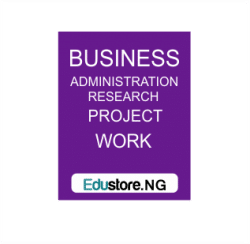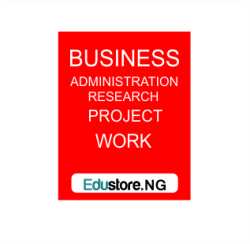ABSTRACT
This study investigated effects of effect of job enrichment techniques on employee performance in Federal University Dutsinma, Katsina State. Job enrichment is one of the cherished goals to achieve employee performance. It is essential to understand how job enrichment is a valuable tool for managing and fostering the successful employee performance. Enriched job consists of various elements like task significance, task identity and skill variety which improves the performance of employees and motivates them to perform zealously. This study intends to focus on the relationship between job enrichment and individual performance. It noted that job enrichment is that type of development in the job environment which may give a worker more challenge, more complete task, more obligation, more prospect for progression, and more effort to contribute his or her ideas for the betterment of the organization. It explores the connection between job enrichment, satisfaction, motivation and performance of employees using the descriptive survey design and utilizing the regression statistical tools to show the effect of Job enrichment techniques on job performance. The study drew its sample from the academic staffs of Federal University Dutsinma, Katsina State. The findings shows that training and development, Work-life balance, job autonomy and job incentive scores are positively and significantly related to job performance which implies that the higher the perceived training and development, work-life balance, job autonomy andjob incentive, the higher would be the level of perceived job performance. It also revealed that job enrichment is a strong predictor of work-related attitudes (employee satisfaction, motivation, and performance). This study concludes that job enrichment provides skill variety, job identity, feeling important in the eyes of others, responsibility, challenge, realizing ones competence, freedom, participation in decision making, performance feedback from the job done, growth and sense of achievement which leads to internal motivation, satisfaction, and high performance of the academic staff.
CHAPTER ONE
INTRODUCTION
1.1 Background of the Study
The survival and growth of a corporate organization depend to a large extent on the productivity of its workforce. Similarly, the wealth of a nation as well as socio-economic wellbeing of its people depends on the effectiveness and efficiency of its various sub components (Akinyele, 2007). Productivity is therefore of great importance to the individual worker, the organization, the national economy at large and therefore also important to the upliftment of the welfare of the citizen and reduction of mass poverty in the polity (Yesufu, 2000 &Akinyele, 2005). Productivity of the Nigerian worker has been adjudged lower than that of counterparts in the western world for decades (Yesufu, 2000 &Thingan, 2005). According to World Bank Report (2009), labour productivity in Nigeria is persistently low, labour productivity recorded an average growth rate of 1.2% from 2000- 2008, this is below the 1.9% recorded in sub Saharan African countries (World Bank, 2009).
The Nigerian educational sector is not only an integral part of the economy, but also an influential part because of its contribution to the economy. Because the sector has remained largely industrious mentally; but rely heavily on number of manual workers, it is also bogged down with the low productivity picture painted above (Wahab, 2001 &Akindele, 2003).
A major method tertiary institutions employ to improve their workers productivity is the use of incentive schemes. Results of researches on the use of these schemes indicated they have induced increased productivity in workers in different proportions, (Aina, 2000; Fagbenle, 2003; Wahab, 1984 &Ameh 2013). While these studies have been instructive, they have however, concentrated on either financial or non-financial incentives.
Job enrichment is a way to motivate workers by giving them opportunity to use a range of their abilities, this is done by giving them more responsibilities and varieties in their job. The purpose of job enrichment is to reverse the negative effects of repetitive tasks requiring autonomy, and having effects such as boredom, lack of flexibility and employees dissatisfaction. An enriched job will contain (a) a range of tasks and challenges of varying toughness (b) a complete unit of work and (c) feedback, encouragement and communication mechanisms. (Leach & Wall, 2004).
The earliest efforts on job enrichment were by Herzberg and later by Hackman and Oldham who designed a job characteristics model. Kotila (2001) reported that the model assumed that if five core job characteristics are present (skill variety, task identify, task significance, autonomy, feedback). Three psychological states critical to motivation will be produced in the worker, namely; meaningfulness of work, responsibilities for work outcomes and knowledge of results. Then there would be five positive job outcomes, namely; internal work motivation, job satisfaction, growth satisfaction low absenteeism and high quality performance. The three groups of advantages were (a) renewal consisting of reduction of boredom, making new contacts, thinking about new career options and change in view point (b) exploration, made up of the following: trying new skills, developing new relationships, testing management and administrative skills and (c) specialization, also consisting; re-education, in-depth exploration using special skills and meeting a need that were underserved. These multifaceted advantages suggest that job enrichment has potentials for increasing workers productivity in general, perhaps also in the educational institutions such as universities.
DISCLAIMER:
- For Reference Only: Materials are for research, citation, and idea generation purposes and not for submission as your original final year project work.
- Avoid Plagiarism: Do not copy or submit this content as your own project. Doing so may result in academic consequences.
- Use as a Framework: This complete project research material should guide the development of your own final year project work.
- Academic Access: This platform is designed to reduce the stress of visiting school libraries by providing easy access to research materials.
- Institutional Support: Tertiary institutions encourage the review of previous academic works such as journals and theses.
- Open Education: The site is maintained through paid subscriptions to continue offering open access educational resources.






